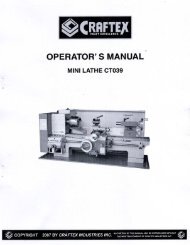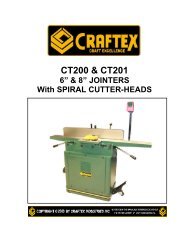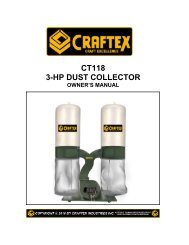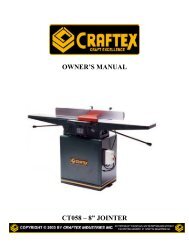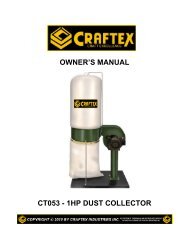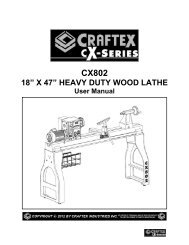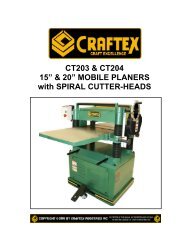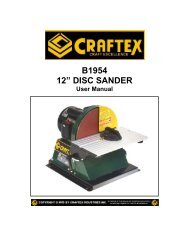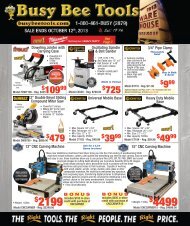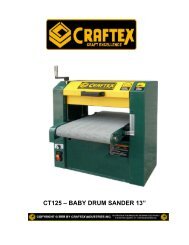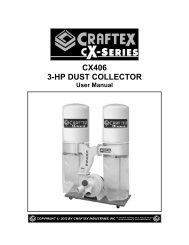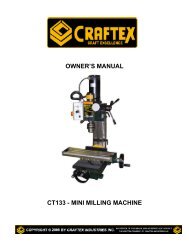CX704 7â x 12â MINI METAL LATHE - Busy Bee Tools
CX704 7â x 12â MINI METAL LATHE - Busy Bee Tools
CX704 7â x 12â MINI METAL LATHE - Busy Bee Tools
You also want an ePaper? Increase the reach of your titles
YUMPU automatically turns print PDFs into web optimized ePapers that Google loves.
<strong>CX704</strong><br />
7” x 12” <strong>MINI</strong> <strong>METAL</strong> <strong>LATHE</strong><br />
User Manual
TABLE OF CONTENTS<br />
General Safety Instructions................................................................................................. 3<br />
Specific Safety Instructions................................................................................................. 4<br />
Features.............................................................................................................................. 5<br />
Physical Features................................................................................................................ 6<br />
Set-Up................................................................................................................................. 7<br />
Un-Packing.......................................................................................................................... 7<br />
Proper Grounding................................................................................................................ 8<br />
Hand Wheel Handles .......................................................................................................... 9<br />
Basic Controls..................................................................................................................... 9<br />
Test Run.............................................................................................................................. 10<br />
Chuck Jaws Replacement................................................................................................... 11<br />
Installing / Removing Chuck or Faceplate........................................................................... 11<br />
Tailstock.............................................................................................................................. 12<br />
Tailstock Positioning ........................................................................................................... 12<br />
Dead Center........................................................................................................................ 13<br />
Tool Post............................................................................................................................. 13<br />
Steady Rest......................................................................................................................... 13<br />
Cross Slide.......................................................................................................................... 14<br />
Compound Slide.................................................................................................................. 15<br />
Carriage .............................................................................................................................. 15<br />
Changing Gears.................................................................................................................. 16<br />
Threads Cutting................................................................................................................... 17<br />
Maintenance........................................................................................................................ 17<br />
Cleaning.............................................................................................................................. 17<br />
Lubrication........................................................................................................................... 18<br />
Gibs Adjustment.................................................................................................................. 18<br />
Motor Brushes Replacement............................................................................................... 19<br />
Headstock & Tailstock Alignment........................................................................................ 19<br />
Wiring Diagram ................................................................................................................... 21<br />
Parts Breakdown................................................................................................................. 22<br />
Parts List ............................................................................................................................. 23<br />
Warranty.............................................................................................................................. 27<br />
2
GENERAL SAFETY INSTRUCTIONS<br />
FOR MACHINES<br />
Extreme caution should be used when operating all power tools. Know your power<br />
tool, be familiar with its operation, read through the user manual and practice safe<br />
usage procedures at all times.<br />
ALWAYS read and understand the<br />
user manual before operating the<br />
machine.<br />
CONNECT your machine ONLY to the<br />
matched and specific power source.<br />
ALWAYS wear safety glasses<br />
respirators, hearing protection and<br />
safety shoes, when operating your<br />
machine.<br />
DO NOT wear loose clothing or<br />
jewelry when operating your machine.<br />
A SAFE ENVIRONMENT is<br />
important. Keep the area free of dust,<br />
dirt and other debris in the immediate<br />
vicinity of your machine.<br />
BE ALERT! DO NOT use prescription<br />
or other drugs that may affect your<br />
ability or judgment to safely operate<br />
your machine.<br />
DISCONNECT the power source when<br />
changing drill bits, hollow chisels,<br />
router bits, shaper heads, blades,<br />
knives, or making other adjustments or<br />
repairs.<br />
NEVER leave a tool unattended while it<br />
is in operation.<br />
NEVER reach over the machine when<br />
the tool is in operation.<br />
ALWAYS keep blades, knives and bits<br />
sharpened and properly aligned.<br />
ALL OPERATIONS MUST BE<br />
performed with the guards in place to<br />
ensure safety.<br />
ALWAYS use push sticks and feather<br />
boards to safely feed your work through<br />
the machine and clamp the work-piece<br />
(when necessary) to prevent the workpiece<br />
from any unexpected movement.<br />
ALWAYS make sure that any tools used<br />
for adjustments are removed before<br />
operating the machine.<br />
ALWAYS keep the bystanders safely<br />
away while the machine is in operation.<br />
NEVER attempt to remove jammed<br />
cutoff pieces until the saw blade has<br />
come to a full stop.<br />
3
<strong>CX704</strong> - <strong>MINI</strong> <strong>METAL</strong> <strong>LATHE</strong><br />
SPECIFIC SAFETY INSTRUCTIONS<br />
This machine is designed and<br />
intended for use by properly trained<br />
and experienced personnel only. If<br />
you are not familiar with the proper<br />
use of lathes, do not use this machine<br />
until proper training and knowledge<br />
has been obtained.<br />
Keep guards in place. Safety guards<br />
must be kept in place and in working<br />
order all the times to ensure safety.<br />
Keep children and visitors away. All<br />
children and visitors should be kept at<br />
a safe distance from the work area.<br />
Wear proper apparel. Loose clothing,<br />
gloves, neckties, rings, bracelets, or<br />
other jewelry may get caught in<br />
moving parts. Non-slip footwear is<br />
recommended. Wear protective hair<br />
covering to contain long hair. Do not<br />
wear any type of gloves.<br />
Always use safety glasses. For the<br />
safety of your eyes, safety glasses<br />
should be used while operating the<br />
lathe.<br />
Do not use the lathe in dangerous<br />
environments. Do no expose the<br />
machine to rain. Do not use the<br />
machine in wet locations.<br />
Check for damaged parts. Check for<br />
proper alignment of moving parts,<br />
broken parts, and any other conditions<br />
that may effect the tools operation.<br />
Remove adjusting keys and<br />
wrenches. Remove all the tools used<br />
for adjustment before turning the<br />
machine on.<br />
Be careful. Do not put your hand close<br />
to the cutter while the machine is<br />
running.<br />
Never leave the lathe unattended while<br />
it is running.<br />
Do not over-reach. Keep proper footing<br />
and balance at all times.<br />
Maintain tools with care. Keep tools<br />
sharp and clean for best and safest<br />
performance. Follow instructions given<br />
in the manual for lubrication and<br />
replacing accessories.<br />
Turn the power OFF. Before making<br />
any adjustments, make sure the switch<br />
is in the “OFF” position and the cord is<br />
un-plugged from the power outlet.<br />
Make sure you have read and<br />
understood all the safety instructions in<br />
the manual and you are familiar with<br />
your metal lathe, before operating it. If<br />
you fail to do so, serious injury could<br />
occur.<br />
WARNING!<br />
The safety instructions given above can not be complete because the environment in<br />
every shop is different. Always consider safety first as it applies to your individual<br />
working conditions.<br />
4
<strong>CX704</strong> – <strong>METAL</strong> <strong>LATHE</strong><br />
FEATURES<br />
MODEL <strong>CX704</strong> – 7” x 12” <strong>MINI</strong> <strong>METAL</strong> <strong>LATHE</strong><br />
As part of the growing line of Craftex metalworking equipment, we are proud to offer the <strong>CX704</strong> a 7” x<br />
12” Mini Metal Lathe. By following the instructions and procedures laid out in this user manual, you will<br />
receive years of excellent service and satisfaction. The <strong>CX704</strong> is a professional tool and like all power<br />
tools, proper care and safety procedures should be adhered to.<br />
Motor....................................................300W, 110 V, 60 Hz, Single Phase, 3 Amps<br />
Number Of Speeds ..............................Variable<br />
Swing Over Bed ...................................7"<br />
Swing Over Cross Slide (RD)...............2-1/8"<br />
Swing Over Saddle ..............................5"<br />
Compound Slide Travel .......................2-3/4"<br />
Carriage Travel ....................................10-1/2"<br />
Cross Slide Travel................................2-3/4"<br />
Maximum Tool Bit Size ........................5/16"<br />
Headstock Construction.......................Cast Iron<br />
Spindle Bore ........................................20mm<br />
Spindle Size .........................................3"<br />
Spindle Taper.......................................MT#3<br />
Range of Spindle Speeds ....................Low 0 - 1100, High 0 - 2500 RPM<br />
Tailstock Travel....................................2-1/2"<br />
Tailstock Taper ....................................MT#2<br />
No. of Inch Threads .............................18<br />
Range of Inch Threads ........................12 - 52 TPI<br />
No. of Metric Threads ..........................10<br />
Range of Metric Threads .....................0.4 - 2.0mm<br />
Bed Construction .................................Cast Iron<br />
Overall Dimension of the lathe.............28" x 12" x 12"<br />
Weight..................................................75 lbs<br />
Warranty ..............................................3 Years<br />
5
<strong>CX704</strong> - <strong>MINI</strong> <strong>METAL</strong> <strong>LATHE</strong><br />
PHYSICAL FEATURES<br />
A. Variable Speed Switch<br />
B. Forward/Reverse Switch<br />
C. Emergency Stop Button<br />
D. Chuck<br />
E. Tool Post<br />
F. Compound Slide<br />
G. Compound Slide Hand Wheel<br />
H. Tailstock Quill<br />
I. Tailstock Quill Lock<br />
J. Tailstock<br />
K. Tailstock Hand Wheel<br />
L. Bed Way<br />
M. Lead Screw<br />
N. Thread Dial<br />
O. Automatic Feed Lever<br />
P. Cross Slide Hand Wheel<br />
Q. Carriage Hand Wheel<br />
R. Gears Cover<br />
6
SETUP<br />
Before setting up your machine you must<br />
read and understand the instructions given<br />
in this manual.<br />
The unpainted surfaces of this lathe are<br />
coated with a rust preventive waxy oil and<br />
you will want to remove this before starting<br />
assembly. Use a solvent cleaner that will<br />
not damage painted surfaces.<br />
WARNING!<br />
<strong>CX704</strong> is a heavy machine, do not overexert<br />
yourself. Use fork truck or other<br />
mechanical devices or get the help of a<br />
friend for safe moving method.<br />
UNPACKING<br />
To ensure safe transportation this machine<br />
is properly packaged and shipped<br />
completely in crates. When unpacking,<br />
carefully inspect the crates and ensure that<br />
nothing has been damaged during transit.<br />
Open the crates and check that the<br />
machine and the parts are in good<br />
condition.<br />
If you can not find any part, check if the part<br />
is already installed on the machine. Some<br />
of the parts come assembled with the<br />
machine because of shipping purposes.<br />
When setting up your machine, you will<br />
want to find an ideal spot where your metal<br />
lathe will most likely be positioned most of<br />
the time.<br />
7
PROPER GROUNDING<br />
Grounding provides a path of least<br />
resistance for electric current to reduce the<br />
risk of electric shock.<br />
<strong>CX704</strong> is for use on a normal 110 volt<br />
circuit. Make sure that the machine is<br />
connected to an outlet having the same<br />
configuration as the plug. If an adaptor plug<br />
is used, it must be attached to the metal<br />
screw of the receptacle. To prevent<br />
electrical hazards, have a qualified<br />
electrician ensure that the line is properly<br />
wired.<br />
The lathe should be wired with a plug<br />
having 3 prongs to fit a 3 prong grounded<br />
receptacle as shown in figure-1. Do not<br />
remove the grounding prong to fit it into a 2<br />
pronged outlet.<br />
WARNING!<br />
Improper connection of the equipmentgrounding<br />
conductor can result in a risk<br />
of electric shock. Check with a qualified<br />
electrician if you are in doubt as to<br />
whether the outlet is properly grounded.<br />
It is strongly recommended not to use<br />
extension cords with your <strong>CX704</strong>. Always<br />
try to position your machine close to the<br />
power source so that you do not need to<br />
use extension cords.<br />
In case if you really find it necessary to use<br />
an extension cord, make sure the extension<br />
cord does not exceed 50-feet in length and<br />
the cord is 14-gauge to prevent motor<br />
damage.<br />
Figure-1 110-Volts outlet for <strong>CX704</strong><br />
8
HAND WHEEL HANDLES<br />
Thread the handles into the longitudinal and<br />
tailstock handwheels and tighten using a<br />
screw driver and an open wrench. See<br />
figure-2 & 3.<br />
Figure-4 Installing the cross feed hand<br />
wheel handle<br />
Figure-2 Installing the tailstock hand wheel<br />
handle<br />
BASIC CONTROLS<br />
This section describes the basic controls of<br />
the <strong>CX704</strong>. Use the figure and read the<br />
descriptions to understand the basic<br />
controls of this lathe.<br />
Figure-3 Installing longitudinal hand wheel<br />
handle<br />
Figure-5 Control panel<br />
The cross slide feed handle comes installed<br />
with the opposite direction for shipping<br />
purposes. Remove the cap srew using a<br />
hex wrench and turn the handle around.<br />
Secure the handle by retightening the cap<br />
screw. See figure-4.<br />
A. FUSE SOCKET: Features a 5 Amp<br />
system fuse.<br />
B. VARIABLE SPEED CONTROL KNOB:<br />
Controls the spindle speed range from 0 -<br />
2500 RPM.<br />
9
C. FORWARD/REVERSE SWITCH:<br />
Changes the direction of rotation of spindle<br />
from clockwise to neutral and counterclockwise.<br />
D. EMERGENCY STOP BUTTON: Shuts<br />
down the power to the motor when pushed<br />
in.<br />
TEST RUN<br />
Once you have assembled your machine<br />
completely, it is then time for a test run to<br />
make sure that the machine works properly<br />
and is ready for operation.<br />
WARNING!<br />
Before starting the lathe, make sure that<br />
you have read and understood the<br />
manual and you are familiar with the<br />
functions and safety features on this<br />
machine. Failure to do so may cause<br />
serious personal injury or damage to the<br />
lathe.<br />
Figure-6 Rear controls<br />
E. LEAD SCREW REVERSE LEVER:<br />
Changes the direction of rotation of<br />
leadscrew for power feed or threading<br />
operations.<br />
F. HIGH/LOW RANGE CONTROL LEVER:<br />
Changes the spindle speed range from high<br />
(0 - 2500 RPM) to low (0 - 1100 RPM).<br />
TO TEST RUN THE <strong>CX704</strong>:<br />
Remove all the tools and objects used for<br />
assembling the machine.<br />
Walk around the machine, ensure all nuts,<br />
bolts, and screws are tightened and the<br />
machine is properly assembled.<br />
Locate the High/Low range control lever at<br />
the back of the lathe and set it to Low<br />
range.<br />
Set the Forward/Reverse button to Forward<br />
position.<br />
Connect the cord to the power source and<br />
lift the Emergency Stop button.<br />
Rotate the Variable Speed Control Knob<br />
slowly and you will hear a click as the<br />
power is turned ON. The spindle speed will<br />
increase as you turn the knob and the lathe<br />
should run with little or no vibration.<br />
During the test run if you hear any unusual<br />
noise coming from the lathe or the spindle<br />
does not rotate smoothly, immediately shut<br />
10
off the machine and investigate to find out<br />
the problem.<br />
If the lathe is running smoothly, let it run for<br />
a few minutes and gradually increase the<br />
RPM using the variable speed control knob<br />
until it reaches the maximum RPM of 2500.<br />
Allow the lathe to run for a few minutes and<br />
stop it by pressing the Emergency Stop<br />
Button.<br />
WARNING!<br />
DO NOT change the direction of rotation<br />
of leadscrew while the lathe is running.<br />
Failure to do so could result damage to<br />
the lathe.<br />
CHUCK JAWS<br />
REPLACMENT<br />
Replacing the chuck jaws is very simple on<br />
<strong>CX704</strong>. You just have to pay attention to<br />
the sequence in which the jaws are loaded<br />
into the chuck.<br />
TO REPLACE THE JAWS:<br />
Make sure the cord is disconnected from<br />
the power source.<br />
Insert the jaw in to the slot#1 and turn the<br />
chuck key clockwise untill the jaw is<br />
engaged with the thread.<br />
Repeat the same step with jaw#2 and then<br />
jaw#3. Make sure the jaws are installed in<br />
sequence.<br />
WARNING!<br />
Make sure not to over-tighten the jaws.<br />
This will damage the jaws. For doing<br />
accentric work, do not install the jaws<br />
into the chuck incorrectly. Always use a 4<br />
jaw chuck for this job.<br />
INSTALLING / REMOVING<br />
CHUCK OR FACEPLATE<br />
The chuck is mounted directly to the spindle<br />
nose plate using studs and hex nuts.<br />
TO REMOVE THE CHUCK / FACEPLATE:<br />
Make sure the cord is disconnected from<br />
the power source.<br />
Hold the chuck with one hand and remove<br />
the three hex nuts securing the chuck to the<br />
to the spindle nose plate using a wrench.<br />
Remove all the jaws on the chuck by<br />
turning the chuck key counter clockwise.<br />
Clean the jaws and the slot in the chuck<br />
with a piece of cloth and make sure there is<br />
no debris.<br />
The jaws are numbered as A, B, C or 1,2,3<br />
and the numbers are in the slot on the<br />
chuck.<br />
Figure-7 Removing the faceplate<br />
11
Tap the chuck / faceplate with a rubber<br />
mallet (if needed) and pull it out.<br />
TO INSTALL THE CHUCK / FACEPLATE:<br />
Remove the studs from the old faceplate /<br />
chuck you just removed and thread them<br />
into the faceplate / chuck you want to<br />
install.<br />
TAILSTOCK POSITIONING<br />
TO ADJUST THE LONGITUDINALLY:<br />
Make sure the cord is disconnected from<br />
the power source.<br />
Loosen the tailstock lock nut securing the<br />
tailstock on the lathe bed with a proper size<br />
wrench. See figure-9.<br />
When threading the studs into the new<br />
faceplate/chuck, make sure the studs are<br />
protruding 1/2" from the check surface.<br />
Align the studs witht holes on the spindle<br />
nose and secure the faceplate / chuck<br />
using the hex nuts removed.<br />
TAILSTOCK<br />
The tailstock slides along the bed way and<br />
can be locked in position by tightening the<br />
hex nut on its base. The tailstock features a<br />
hand wheel which moves the MT2 tailstock<br />
quill in or out and a lock lever to secure the<br />
quill in position. The offset screw on the<br />
tailstock helps maintain tailstock position<br />
during tailstock offset adjustment. See<br />
figure-8.<br />
Figure-9 Loosening the tailstock lock nut<br />
TO OFFSET THE TAILSTOCK:<br />
Loosen the tailstock lock nut shown in<br />
figure-9 and remove the tailstock.<br />
Loosen the tailstock offset cap screw<br />
shown in figure-8 a few turns and slide the<br />
tailstock back onto the bed.<br />
Adjust the tailstock to the desired offset and<br />
tighten the setscrew to secure the tailstock<br />
in position.<br />
Remove the tailstock from the lathe bed<br />
and tighten the offset cap screw.<br />
Figure-8 Tailstock controls<br />
Slide the tailstock back onto the lathe bed<br />
and tighten the tailstock lock nut to secure<br />
the tailstock in position.<br />
12
Repeat the above steps often to change the<br />
tailstock offset.<br />
DEAD CENTER<br />
When the work-piece is 3 times longer than<br />
its diameter should be supported by a dead<br />
or live center.<br />
TO USE THE TOOL POST:<br />
Attach the cutting tool you want to use to<br />
the tool post and secure it by tightening cap<br />
screws. See figure-10.<br />
TO INSTALL THE DEAD CENTER:<br />
Make sure the cord is disconnected from<br />
the power source.<br />
Turn the tailstock hand wheel so that the<br />
quill is about 1" out.<br />
Use a piece of cloth and clean the tailstock<br />
quill and the dead center and make sure<br />
there is no dirt, debris, grease or oil on<br />
them.<br />
Now, insert the dead center into the<br />
tailstock quill and the taper will hold the<br />
center in position.<br />
Make sure the quill does not extend less<br />
than 0 and not greater than 1-1/2" out of the<br />
tailstock while operation.<br />
TO REMOVE THE DEAD CENTER:<br />
Turn the tailstock hand wheel to move the<br />
quill all the way back into the tailstock and<br />
dead center will come out of the quill.<br />
TOOL POST<br />
A four-way tool post is supplied with <strong>CX704</strong><br />
which rotates to four 90° preset stops or at<br />
any angle in between. Cutting tools can be<br />
attached and removed by tightening or<br />
loosening the cap screws on the tool post.<br />
Figure-10 Proper tool post setup<br />
The tip of the cutting tool should be right at<br />
the centerline on the work-piece. If it is not,<br />
use shims under the cutting tool to bring the<br />
tool up, to the centerline of the work-piece.<br />
STEADY REST<br />
The steady rest supports long, small<br />
diameter stock that otherwise could not be<br />
turned. The steady rest can also replace<br />
the tailstock to allow for cutting tool acces<br />
at the outboard end of your work-piece.<br />
TO SET-UP THE STEADY REST:<br />
Loosen the hex nuts and knurled screws<br />
and open the sliding fingers until the steady<br />
rest can be moved with its finger around the<br />
work-piece.<br />
Slide the work-piece between the steady<br />
rest fingers and secure the two ends of the<br />
work-piece between chuck and dead center<br />
or two centers as required.<br />
13
Position the steady rest on the lathe bed<br />
where desired and secure it in place by<br />
tightening the nut.<br />
CROSS SLIDE<br />
The cross slide allows the cutting tool to<br />
travel perpendicular to the bed and features<br />
a scale and a hand wheel having<br />
graduations of 0.001".<br />
TO ADJUST THE CROSS SLIDE:<br />
Move the cross slide back and forth a few<br />
turns using the hand wheel and then move<br />
it to your starting point. This will clear any<br />
free movements in the leadscrew<br />
increasing accuracy on cross slide scale.<br />
Figure-11 Installing steady rest<br />
Hold the hand wheel with one hand and<br />
turn the scale so that the "0" mark on the<br />
scale lines up with the "0.000" mark on the<br />
cross slide. See figure-12.<br />
Tighten the knurled screws so that the<br />
fingers are snug but not tight against the<br />
work-piece and the work-piece can rotate<br />
easily.<br />
Tighten three hex nuts shown in and<br />
lubricate the sliding points with machine oil.<br />
IMPORTANT<br />
The sliding fingers of the steady rest<br />
should receive periodic lubrication when<br />
used, to prevent premature wear. The<br />
fingers tips will show wear after<br />
sometimes and will need to be milled or<br />
filed for new contact surface.<br />
Figure-12 Adjusting the cross slide<br />
When making the next cut, make sure to<br />
clear the backlash before moving the cross<br />
slide forward to the "0" mark.<br />
14
COMPOUND SLIDE<br />
The compound slide rotates at a set angle<br />
and features a graduation scale of 0.001".<br />
TO ADJUST THE COMPOUND SLIDE:<br />
MANUAL MOVEMENT<br />
The manual movement of the carriage can<br />
be controlled using the hand wheel shown<br />
in figure-14.<br />
Loosen the bolts located on the compound<br />
slide shown in figure-13.<br />
Figure-14 Carriage hand wheel<br />
Figure-13 Loosening the bolts<br />
Rotate the compound slide to the desired<br />
angle.<br />
Tighten the bolt, loosened in the first step<br />
and make sure the compound slide does<br />
not move during tightening.<br />
Move the compound slide back and forth<br />
using the hand wheel and make sure the<br />
threads are engaging and there is no<br />
backlash, before you set the hand wheel<br />
scale to "0".<br />
CARRIAGE<br />
The carriage allows the cutting tool to move<br />
along the length of the lathe bed and the<br />
carriage movement can be controlled<br />
manually or automatically.<br />
Rotating the hand wheel clockwise will<br />
move the carriage to the right and counterclockwise<br />
will move the carriage to the left<br />
on the lathe bed.<br />
AUTOMATIC MOVEMENT<br />
To use the autamatic carriage movement,<br />
set the carriage to the desired starting point<br />
using the carriage hand wheel.<br />
Turn the variable speed control dial to the<br />
required RPM.<br />
Move the automatic feed lever down to<br />
engage the half-nut and activate the<br />
automatic feed feature. See figure-15.<br />
To deactivate the automatic feed feature,<br />
simply lift the the automatic feel lever up.<br />
Automatic feed feature also works when<br />
operating the lathe in reverse direction by<br />
changing the leadscrew after tunring the<br />
lathe OFF.<br />
15
TO CHANGE THE GEARS:<br />
Make sure the cord is disconnected from<br />
the power source.<br />
Remove the gear cover to access the<br />
gears. Loosen the adjusted to disengage<br />
the gears from each other.<br />
Figure-15 Automatic feed lever<br />
Remove the gears and install the new<br />
gears according to the chart. See figure-17<br />
& 18.<br />
Reinstall the adjuster and close the close<br />
the cover.<br />
WARNING!<br />
DO NOT change the direction of rotation<br />
of leadscrew while the lathe is running.<br />
Failure to do so could result damage to<br />
the lathe.<br />
CHANGING GEARS<br />
The gears on <strong>CX704</strong> can be changed for a<br />
variety of different feed rates.<br />
Figure-17 Threads per inch chart<br />
Figure-16 Gears and adjuster<br />
Figure-18 Metric thread chart<br />
16
THREADS CUTTING<br />
Several different threads can be cut using<br />
the proper combination of gears and<br />
settings.<br />
Set the compound slide to the proper angle<br />
required for the cut and align the tip of the<br />
cutting tool with the center of the workpiece.<br />
Engage the thread dial with the leadscrew<br />
accodring to the chart (figure-19).<br />
Install the gears according to the thread<br />
charts (figure-17 & 18) to get the required<br />
RPM for the job.<br />
Turn the spindle ON and select the RPM<br />
and make sure that the carriage is moving<br />
to the correct direction for cutting.<br />
MAINTENANCE<br />
During the life of your machine, you will<br />
need to practice some regular maintenance<br />
to keep your lathe in peak performance<br />
condition.<br />
Check your machine daily for the following<br />
before use:<br />
* Loose mounting nuts and bolts<br />
* Worn or damaged cord<br />
* Damaged parts<br />
* Any other unsafe condition<br />
CLEANING<br />
Treat the machine with care, keep it clean<br />
and grease and lubricate it regularly. Only<br />
through good care you can be sure that the<br />
working quality of the machine will remain<br />
constant.<br />
Oil, grease and cleaning agents are<br />
pollutants and must not be disposed off<br />
through the drains or in normal garbage.<br />
Dispose of those agents in accordance with<br />
current local environmental regulations.<br />
Cleaning rags impregnated with oil, grease<br />
and cleaning wool in a suitable closed<br />
vessel and disposed of in an<br />
environmentally sound way. Do not put<br />
them with normal garbage.<br />
During operation, the chips which fall onto<br />
the sliding surface should be cleaned in a<br />
timely fashion. Frequent inspections should<br />
be made to prevent chips from falling into<br />
the position between the carriage and bed<br />
way.<br />
Figure-19 Thread dial chart<br />
17
Every day, after the operation, eliminate all<br />
the chips and clean different parts of the<br />
machine tool and apply machine tool oil to<br />
prevent from rusting.<br />
Good housekeeping practice should be<br />
followed on a daily basis keeping your lathe<br />
clean and well lubricated.<br />
LUBRICATION<br />
Lubricate all slide ways of the lathe bed,<br />
compound slide and cross slide lightly<br />
before every use using 10-30W oil or<br />
similar.<br />
GIBS ADJUSTMENT<br />
The cross slide and the compound slide<br />
gibs will need to be adjusted after<br />
sometimes.<br />
TO ADJUST THE CROSS-SLIDE AND<br />
COMPOUND SLIDE GIBS:<br />
Disconnect the cord from the power source.<br />
Loosen the lock nuts on the set screws<br />
shown in figure-20.<br />
The change gears, cross slide and<br />
compound slide lead screws must also be<br />
lightly lubricated with lithium based grease<br />
after every 6 months.<br />
Lubricate the transmission gears using<br />
lithium based grease every year. To<br />
lubricate the transmission gears, disconnect<br />
the cord from the power source and remove<br />
the front control panel, remove the ground<br />
wire from the headstock and spray grease<br />
in the hole. Rotate the chuck with your hand<br />
and shift the gears high to low.<br />
Figure-20 Cross slide and compound slide<br />
gibs adjustment screws<br />
Tighten or loosen the set screws as<br />
required and check the sliding movement of<br />
the cross slide / compound slide. It should<br />
move smoothly without any play.<br />
Once the set screws are adjusted, tighten<br />
the lock nuts to secure the set screws in<br />
position.<br />
18
MOTOR BRUSHES<br />
REPLACEMENT<br />
TO REPLACE THE MOTOR BRUSHES:<br />
TO CHECK THE CENTERS ALIGNMENT:<br />
Center drill a 6" piece of bar stock on one<br />
end and position it between the headstock<br />
and tailstock as shown in figure-22.<br />
Make sure the cord is disconnected from<br />
the power source.<br />
Remove the front and rear caps shown in<br />
figure-21.<br />
Figure-22 checking headstock and tailstock<br />
alignment<br />
Turn approximately 0.010" off diameter.<br />
Figure-21 Front motor brush cap<br />
Measure the stock with a micrometer. If the<br />
stock is thicker at the tailstock end, the<br />
tailstock needs to be moved towards you by<br />
half the amount of taper. See figure-23.<br />
Replace the motor brushes with new ones<br />
and tighten the caps.<br />
HEADSTOCK &<br />
TAILSTOCK ALIGNMENT<br />
The headstock and tailstock alignment has<br />
been adjusted properly in the factory before<br />
the machine is shipped to you. However,<br />
after lengthy operation, the headstock and<br />
tailstock may be out of alignment.<br />
Figure-23 Stock thicker at the tailstock end<br />
If the stock is thinner at the tailstock end,<br />
the tailstock needs to be moved away from<br />
you half the amount of taper. See figure-24.<br />
19
Figure-24 Stock thinner at the tailstock end<br />
TO MOVE THE TAILSTOCK:<br />
Make sure the switch is in the OFF position<br />
and the cord is disconnected from the<br />
power outlet.<br />
Adjust the tailstock offset half the amount<br />
by turning the offset screw.<br />
Turn another 0.010" off the stock and check<br />
for taper. Repeat this procedure until the<br />
tailstock is aligned with the headstock.<br />
20
WIRING DIAGRAM FOR <strong>CX704</strong><br />
21
<strong>CX704</strong> PARTS LIST<br />
PART# DESCRIPTION QTY<br />
1 Bed Way 1<br />
2 3 Jaws Chuck 1<br />
3 Spindle 1<br />
4 Screw M6 × 25 5<br />
6 Nut M6 10<br />
7 Key M5 × 50 1<br />
8 Key M4 × 8 2<br />
9 Screw M5 × 12 6<br />
10 Cover 2<br />
11 Ball Bearing 2<br />
12 Spacer 2<br />
13 Head Stock Casting 1<br />
14 Gear 1<br />
15 Spacer 1<br />
16 Spindle Gear 1<br />
17 Nut M27×1.5 2<br />
18 Screw M5×8 1<br />
19 Steel Ball 2<br />
20 Fixed Spring 3<br />
21 Screw M6×6 1<br />
22 Retaining Ring M12 2<br />
23 Ball Bearings 2<br />
24 Gear 1<br />
25 Parallel Key M4 × 45 1<br />
26 H/L Gear Shaft 1<br />
27 Pulley 1<br />
28 Retaining Ring M10 1<br />
29 Timing Belt 1<br />
30 Shifting Fork 1<br />
31 Shifting Arm 1<br />
32 Shifting Knob 1<br />
33 Shifting Lever 1<br />
34 Shifting Grip 1<br />
35 Handle 1<br />
36 Fanning strip 1<br />
37 Compressive Spring 1<br />
38 Indicator 1<br />
39 Pinion 25T 1<br />
40 Support Screw 2<br />
41 Pinion 20T 1<br />
42 Fixed Cover 1<br />
43 Screw M6×20 5<br />
45 Gear 45T 1<br />
46 Shaft 1<br />
47 Parallel Key 1<br />
48 Gear shelf 1<br />
49 Screw M5 × 18 2<br />
50 Pinion 20T 2<br />
51 Washer 2<br />
52 Screw M6 × 8 4<br />
53 Cover 1<br />
54 Screw M5 × 45 2<br />
55 Threads Cutting Chart 1<br />
56 Screw M5 × 8 1<br />
57 Washer M5 1<br />
58 Bush W/Key 1<br />
59 Gear 80T 2<br />
60 Shaft 1<br />
61 Support Plate 1<br />
62 Washer M8 2<br />
63 Nut M8 4<br />
64 Shaft 1<br />
67 Screw M6×16 2<br />
69 Screw M4×10 3<br />
23
70 Slide carriage box 1<br />
71 Slope lock block 1<br />
72 Washer 3<br />
73 Screw M4 × 8 2<br />
74 Key 2<br />
75 Half nuts 2<br />
76 Angle Block 1<br />
77 Screw M4×10 2<br />
78 Groove plate opening 1<br />
79 Handle seat 1<br />
80 Shaft 1<br />
81 Feeding Gear (A) 11T/54T 1<br />
82 Feeding Gear (B) 24T 1<br />
83 Screw 1<br />
84 Hand wheel assembly 2<br />
85 Hand shank 2<br />
86A Three Ball Handle 1<br />
86B Three Ball Handle 1<br />
87 Dial 2<br />
88 Positioning scale set 1<br />
89 Lead Screw 1<br />
90 Nut M5 5<br />
91 Screw M6×12 6<br />
92 Slide Plate 2<br />
93 Saddle 1<br />
94 Gib Strip 1<br />
95 Feeding Nut 1<br />
96 Wheel aligner 1<br />
97 Screw M8 × 20 2<br />
98 Nut M4 8<br />
99 Screw M4 × 16 3<br />
100 Cross Slide 1<br />
101 Screw M5 × 10 5<br />
102 Screw M4 × 8 2<br />
105 Positioning plate 1<br />
106 Screw M4 × 14 3<br />
107 Gib Strip 1<br />
108 Small carriage 1<br />
109 Tool Rest fixed position 1<br />
110 Screw M6 × 25 9<br />
111 Tool rest handle seat 1<br />
112 Tool Rest 1<br />
113 Stud M10 × 65 1<br />
114 Lead screw 1<br />
115 Indication position 1<br />
116 Screw M4 × 12 4<br />
119 Washer 1<br />
120 Model Label 1<br />
122 Indicator Table Label 1<br />
123 Electric Cover 1<br />
124 Plug 1<br />
125 Non-slip mat 4<br />
126 Chip Tray 1<br />
127 Bracket 1<br />
128 Key 2<br />
129 Lead Screw 1<br />
131 Bracket 1<br />
133 Screw M3×10 3<br />
134 Rack 1<br />
135 Clamp Plate 1<br />
136 Washer M10 1<br />
137 Screw M5 × 16 1<br />
138 Tailstock 1<br />
139 Tailstock Lead Screw 1<br />
140 Bearing flange 1<br />
141 Screw M4 × 10 4<br />
142 Tailshaft 1<br />
143 Center 1<br />
144 Stud M8 × 40 1<br />
145 Pad 1<br />
24
146 Handle seat 1<br />
148 Pulley 1<br />
150 Motor 1<br />
151 Motor Cover 1<br />
152 Power cord Guard 1<br />
153 Rear Splash Guard 1<br />
154 H/L Label 1<br />
155 H/L Label 1<br />
156 Warning Label 1<br />
157 Gear 30T 1<br />
158 Gear 35T 1<br />
159 Gear 40T 2<br />
160 Gear 45T 1<br />
161 Gear 50T 1<br />
162 Gear 55T 1<br />
163 Gear 57T 1<br />
164 Gear 60T 1<br />
165 Gear 65T 1<br />
166 Claw(cover) 1<br />
167 3-Jaw chuck Key 1<br />
171 Clamp Block 1<br />
172 Check Ring 1<br />
173 Screw M5 ×8 4<br />
174 Protector 1<br />
175 Screw M5 × 8 7<br />
177 Screw M6 × 20 2<br />
178 Emergency Stop Switch 1<br />
179 Fuse 1<br />
180<br />
Variable Speed Control<br />
Knob 1<br />
181 Toggle Switch 1<br />
182 PC Board 1<br />
184 Screw M5×10 1<br />
185 Spring washer 5 1<br />
187 Key 1<br />
188 Small spacer 1<br />
190 Spring 2<br />
192 Washer 4<br />
193 Screw M8*55 2<br />
194 Screw M4*38 1<br />
195 Nut M4 1<br />
196 Plate of tailstock 1<br />
197 Screw M5*16 3<br />
198 Base body cover 1<br />
199 Screw M5*25 1<br />
201 Chuck guard 1<br />
202 Shaft 1<br />
205 Screw M6 1<br />
206 Nut M6 2<br />
207 Compression Spring 1<br />
208 Washer 6 2<br />
209 Screw M3*4 4<br />
210 Switch Cover 1<br />
212 Permanent seat 1<br />
232 Screw M4×6 7<br />
235 Clamp Cover 1<br />
236 Screw 1<br />
237 Compression Spring 1<br />
238 Screw M6×30 1<br />
239 Washer 1<br />
251 Cylinder Pin 1<br />
252 Turntable 1<br />
253 Screw 3<br />
254 Cover 1<br />
255 Micro switch 1<br />
256 Dust sheet 1<br />
257 Lead Screw Cover 1<br />
258 Washer 4 3<br />
266 Washer 6 3<br />
268 Screw 10 1<br />
25
270 Support Pin 1<br />
272 Protective Cover 1<br />
303 Washer 1<br />
318 Screw M5*20 1<br />
319 Washer 1<br />
320 Screw M6×10 4<br />
321 Screw M6×16 4<br />
322 Key 1<br />
323 Screw M8×25 3<br />
324 Screw M4×8 2<br />
325 Flange 1<br />
326 Screw 2<br />
327 Screw M6×8 1<br />
26
WARRANTY<br />
CRAFTEX 3 YEARS LIMITED WARRANTY<br />
Craftex warrants every product to be free from defects in materials and agrees to correct such defects where<br />
applicable. This warranty covers three years for parts and 90 days for labor (unless specified otherwise), to the<br />
original purchaser from the date of purchase but does not apply to malfunctions arising directly or indirectly from<br />
misuse, abuse, improper installation or assembly, negligence, accidents, repairs or alterations or lack of<br />
maintenance.<br />
Proof of purchase is necessary.<br />
All warranty claims are subject to inspection of such products or part thereof and Craftex reserves the right to<br />
inspect any returned item before a refund or replacement may be issued.<br />
This warranty shall not apply to consumable products such as blades, bits, belts, cutters, chisels, punches<br />
etceteras.<br />
Craftex shall in no event be liable for injuries, accidental or otherwise, death to persons or damage to property or<br />
for incidental contingent, special or consequential damages arising from the use of our products.<br />
RETURNS, REPAIRS AND REPLACEMENTS<br />
To return, repair, or replace a Craftex product, you must visit the appropriate <strong>Busy</strong> <strong>Bee</strong> <strong>Tools</strong> showroom or call 1-<br />
800-461-BUSY. Craftex is a brand of equipment that is exclusive to <strong>Busy</strong> <strong>Bee</strong> <strong>Tools</strong>.<br />
For replacement parts directly from <strong>Busy</strong> <strong>Bee</strong> <strong>Tools</strong>, for this machine, please call 1-800-461-BUSY (2879), and<br />
have your credit card and part number handy.<br />
All returned merchandise will be subject to a minimum charge of 15% for re-stocking and handling with the<br />
following qualifications.<br />
Returns must be pre-authorized by us in writing.<br />
We do not accept collect shipments.<br />
<br />
<br />
<br />
<br />
<br />
<br />
<br />
<br />
<br />
Items returned for warranty purposes must be insured and shipped pre-paid to the nearest warehouse<br />
Returns must be accompanied with a copy of your original invoice as proof of purchase. Returns must be in<br />
an un-used condition and shipped in their original packaging a letter explaining your reason for the return.<br />
Incurred shipping and handling charges are not refundable.<br />
<strong>Busy</strong> <strong>Bee</strong> will repair or replace the item at our discretion and subject to our inspection.<br />
Repaired or replaced items will be returned to you pre-paid by our choice of carriers.<br />
<strong>Busy</strong> <strong>Bee</strong> reserves the right to refuse reimbursement or repairs or replacement if a third party without our<br />
prior authorization has carried out repairs to the item.<br />
Repairs made by <strong>Busy</strong> <strong>Bee</strong> are warranted for 30 days on parts and labour.<br />
Any unforeseen repair charges will be reported to you for acceptance prior to making the repairs.<br />
The <strong>Busy</strong> <strong>Bee</strong> Parts & Service Departments are fully equipped to do repairs on all products purchased from us<br />
with the exception of some products that require the return to their authorized repair depots. A <strong>Busy</strong> <strong>Bee</strong><br />
representative will provide you with the necessary information to have this done.<br />
For faster service it is advisable to contact the nearest <strong>Busy</strong> <strong>Bee</strong> location for parts availability prior to<br />
bringing your product in for repairs.<br />
27



